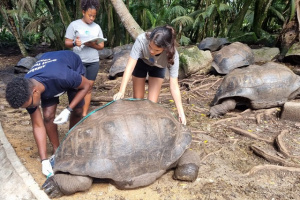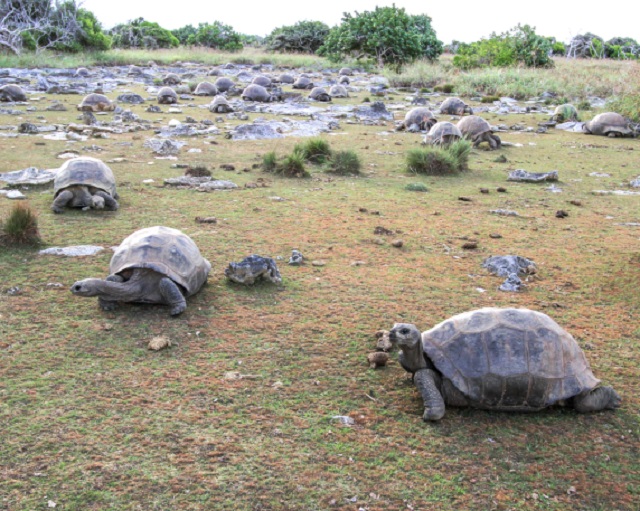Seychelles' Aldabra giant tortoises are "so crucial to island restoration projects," says IOTA official
The Interview |Author: Salifa Karapetyan Edited by: Betymie Bonnelame | October 3, 2023, Tuesday @ 09:07| 84239 views
The census was kicked off at the Cap Lazare Nature Reserve in May. (Seychelles News Agency)
In 2018, in a move to underscore the importance of the Seychelles' Aldabra giant tortoises and shed light on the plight of the species, a group of conservationists and philanthropists set up an Indian Ocean Tortoise Alliance (IOTA).
The alliance, which was initiated at the recent Paris Peace Conference, is an inclusive, Seychelles-anchored non-profit organisation dedicated to the conservation of the iconic Aldabra tortoise, found on the Aldabra Atoll, a UNESCO World Heritage site, which is managed by the Seychelles Islands Foundation (SIF).
SNA met with IOTA's project director, Rich Baxter, to learn more about its mission in Seychelles and projects.
SNA: Tell us more about IOTA and what does it do?
RB: IOTA is the Indian Ocean Tortoise Alliance. The founders of IOTA wanted to create an organisation in Seychelles that brought together all research that's being done on the Aldabra giant tortoises in the western Indian Ocean today. Not only in Seychelles but also in Mauritius, Rodrigues, and Madagascar as well.
There are a lot of organisations in those countries that are using the Aldabra giant tortoises from Seychelles to rewild or replenish their islands. These islands used to have giant tortoises and now they don't. At the same time, IOTA is trying to create collaborations and use the tortoises as an emblem for creating a wider conservation community within the western Indian Ocean.
We want the Aldabra giant tortoises to be seen as an icon that can be highlighted in multiple ways to create conversations about conservation and how we all work together as island nations.
We do that in several different ways. On the research side, we focus on rewilding, which is replacing extinct giant tortoises with the Aldabra giant tortoises and restoring ecosystem function. Then we have an educational pillar whereby we go to schools and explain why the tortoises are important for the islands, how to look after them, and why they're also important culturally in the Seychelles.
We also do a little bit of ecotourism as well, trying to work with the hotels, islands, and private islands all over Seychelles that keep tortoises, to ensure that they are kept in the best condition for the visitors to go and see them. We also look at how to develop this species as an ambassador for conservation around the world. There has been a lot of good success using these animals in conservation around the world. It could be a game changer for promoting Seychelles, the tortoises, and the methodology that we use for conservation.
 |
| The agreement was signed by IOTA's project director, Rich Baxter (right), and by the principal secretary for environment Dennis Matatiken. (Seychelles News Agency) Photo License: CC-BY |
SNA: Why did IOTA choose Seychelles as the country to establish its base?
RB: Fundamentally, this is where the tortoises are from. We thought it very important that the focus should be on Seychelles. One of the other aims is to try and bring giant tortoise research to the University of Seychelles and drive the rewilding research from here.
A lot of Seychellois don't realise how much of a benefit the species have been in Mauritius and Rodrigues. Conservationists out there came up with this concept to replace their extinct tortoises with Aldabra giant tortoises and not many people realise just how crucial that's been to the success of their conservation efforts. It's time for Seychelles to start recognising that and then also celebrate it.
SNA: Tell us about the current projects directly targeting Aldabra giant tortoises.
RB: Project-wise, we're still in the early stages of developing the organisation, making the connections, and getting to a point where we can start developing our own projects. IOTA is really about collaboration and working with as many different partners as possible, focused on the tortoises.
We work with partners, like on Grande Soeur, where we will go and measure the tortoises, and look at their health and what they are doing. We're trying to redefine the protocols around certain aspects of the giant tortoises, so microchipping the tortoises to align everyone's methodology. Protocols can help everyone be on the same page, working with the same method.
We're working with some of the hotels to improve their tortoise enclosures, doing health checks on privately owned tortoises. We are invited to people's houses to check on their tortoises, check out the enclosures, and maybe suggest a few adjustments that can be made to improve the livelihoods of the tortoises. We also go to schools and give presentations about the tortoises and their roles as ecosystem engineers on these islands.
 |
| The atoll is home to the world's largest wild Aldabra giant tortoise population of 100,000. (Richard Baxter, IOTA) Photo License: All Rights Reserved |
SNA: One of the most recent projects is the Aldabra giant tortoise census. What stage has the project reached and what are some of the challenges faced so far?
RB: The census has started well. On the census, we are working in partnership with the Ministry of Environment. They are the lead in the census and IOTA is facilitating with some training and identifying places that have tortoises. We do encourage private owners to register their tortoises for the census. This would help us a lot because we really want to try and understand how many tortoises there are across these inner islands and the outer islands eventually.
Most of the focus has been on hospitality establishments - hotels and guest houses - that have tortoises. However, we would like to get more private owners to register. We can come and measure them and microchip them. By doing so the owners can follow the tortoises over time and if the tortoise is sick, we will know exactly which tortoise it is, and we can keep an eye on it.
Another challenge is that because tortoises are intergenerational pets that get passed down between family members. Records of when the tortoises came into the family are lost, so it is difficult to age them, but we are addressing this with new research.
SNA: In October, IOTA will be hosting 'The Giant Tortoise Workshop 2023'. What is its aim and who will be attending?
RB: I think it's the first workshop of its kind in the western Indian Ocean. It will be three days of activities. There will be a symposium on the first day where we'll be highlighting all the different research that's going on around these tortoises. It will take place on October 5 at the STC conference room. Scientists and conservationists from Seychelles, Madagascar, Mauritius, and other countries will be presenting.
We will have a training day for the rangers, people who work with giant tortoises, and anybody who's interested. On Saturday, the third day, we have a public afternoon where people can come and interact with the tortoises. It's all free and open to the public, anyone can register to attend these events on our website - www.iotaseychelles.org.
People can expect to learn a lot about the research that's happening, not just in Seychelles but also in Mauritius, Rodrigues, and Madagascar. They will see that these animals are super important on these islands. They will learn more about Aldabra Atoll itself. Action day is geared towards rangers and tortoises' carers, with discussions on the process of rewilding, tortoise research protocols, and the development of an action plan for the future protection of giant tortoises in Seychelles.
The public day will be a day of fun, for people to get a bit of exposure to giant tortoises. There will be fun and games. We want to get public support to protect the tortoises and recognise them as conservation ambassadors for Seychelles and beyond.
SNA: How would IOTA describe the status of the Aldabra giant tortoise population in Seychelles?
RB: There are two species of giant tortoises left in the world. Everyone knows about the Galapagos tortoises because Charles Darwin went there. If Darwin had come to Seychelles, the Aldabra giant tortoise could have been more widely known. We have four times the population of giant tortoises in Seychelles as compared to the Galapagos Islands. There are different giant tortoise species in the Galapagos, but in Seychelles, we only have one species of tortoise.
 |
| Taking a blood sample from an Aldabra giant tortoise. (Dennis Hansen) Photo License: All Rights Reserved |
The species, Aldabrachelys gigantea, is listed as "vulnerable" on the IUCN Red List. As a result of climate change, they face threats of rising sea levels, higher air temperatures, and longer droughts which are already happening on Aldabra Atoll. Another issue is that the population on Aldabra is fairly old and if there are not enough juvenile tortoises surviving, we may see the population collapse in 50 years' time. This is why SIF [the Seychelles Islands Foundation] is really pushing to eradicate rats and cats from the atoll, as these predators could be the reason that we don't see many young tortoises on Aldabra.
To mitigate these threats, IOTA would like to increase the populations on the higher inner islands to protect the genetic diversity of the population for future generations of tortoises.
SNA: You've mentioned that this species is important to the island ecosystem. What are their roles?
RB: Tortoises are more than just adorable pets. This animal is on the coat of arms of Seychelles, yet it doesn't get the sort of level of appreciation as the Coco de Mer for example. They are phenomenal animals. When you have them in large numbers, they act like the elephants of the Savannah. They move through the islands and they do a number of things. For starters, they'll eat, they'll eat a lot. Though they are omnivorous, tortoises primarily eat vegetation. By doing this, they shape the landscapes of the islands they occupy.
For example, they'll create areas of open grassland, forest, trails, and mud pools. They can reach up to about 1.3 metres to eat fruit and leaves. This creates a clear understory beneath the trees, which gives seedlings more space to grow and helps in the natural recovery of the forest.
As the tortoises move around, they disturb the soil with their weight. This allows nutrient cycling to happen. At the same time, while they're eating all this food, they produce a lot of dung, which is full of nutrients. This is crushed and pushed into the soil making the soil very fertile.
Tortoises are amazing at seed dispersal. They can eat a lot of fruit like those of the native palms that we have in Seychelles. The seeds from these fruits go through their gut and don't get destroyed - in fact, they get cleaned - and then deposited in a big ball of dung from where they can germinate. This engineering quality is what makes the tortoises so crucial to island restoration projects.
Because they live so long, this can go on for a very, very long time. As long as your population is regenerating, your projects can go on forever. They're able to engineer habitats on islands that are suitable for the introduction of other native species. Aldabra would not be Aldabra if it wasn't for the giant tortoises.
Back
